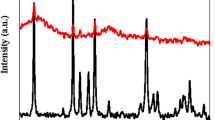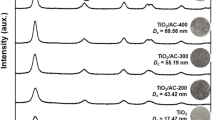Abstract
In the present study, we focused on the synthesis of copper oxide nanowires decorated on activated carbon (AC@CuO-NWs) for the removal of methylene blue (MB) from aqueous solutions. The AC@CuO-NWs nanocomposite is synthesized via simple precipitation method and characterized by using various techniques which includes scanning electron microscopy (SEM), Energy-dispersive X-ray spectroscopy (EDX), and X-rays diffraction analysis (XRD). XRD results confirmed the monoclinic structure of CuO-NWs with the average crystalline size ~ 17.48 nm. The SEM images indicated the wire-like structure and EDX analysis confirms the CuO nanomaterial. The SEM image shows that nanowires are agglomerated to form like flower shape. The batch adsorption experiments were optimized using various parameters such as pH, contact time, initial dye concentration, kinetic and isotherm studies. The results showed that the adsorption processes were well fitted with the PSO model. The adsorption equilibrium experimental data fitted to the Langmuir models with a maximum adsorption capacity of 141.73 mg/g at 328 K. The thermodynamics results reveal that the adsorption processes are spontaneous and endothermic in nature. The high negative value of ΔG° and a low value of ΔH° show the feasibility with physisorption and endothermic nature of the adsorption process. The acquire results indicating that AC@CuO-NWs based nanocomposite is having the high MB adsorption capacity in short equilibrium period and good substitute as the low-cost adsorbent in wastewater treatment. The synthesis of AC@CuO-NWs nanocomposite material is simple, easy and scale-up that might be efficiently used in water treatment technologies.








Similar content being viewed by others
References
M.C.S. Reddy, L. Sivaramakrishna, A.V. Reddy, The use of an agricultural waste material, Jujuba seeds for the removal of anionic dye (Congo red) from aqueous medium. J. Hazard. Mater. 203, 118–127 (2012)
A.S. Bhatt, P.L. Sakaria, M. Vasudevan, R.R. Pawar, N. Sudheesh, H.C. Bajaj, H.M. Mody, Adsorption of an anionic dye from aqueous medium by organoclays: equilibrium modeling, kinetic and thermodynamic exploration. RSC Adv. 2, 8663–8671 (2012)
L. Sivarama Krishna, A. Sreenath Reddy, A. Muralikrishna, W.Y. Wan Zuhairi, H. Osman, A. Varada, Reddy, Utilization of the agricultural waste (Cicer arientinum Linn fruit shell biomass) as biosorbent for decolorization of Congo red, Desal. Water Treat. 56, 2181–2192 (2015)
F. Nekouei, S. Nekouei, I. Tyagi, V.K. Gupta, Kinetic, thermodynamic and isotherm studies for acid blue 129 removal from liquids using copper oxide nanoparticle-modified activated carbon as a novel adsorbent. J. Mol. Liq. 201, 124–133 (2015)
C. Wang, C. Feng, Y. Gao, X. Ma, Q. Wu, Z. Wang, Preparation of a graphene-based magnetic nanocomposite for the removal of an organic dye from aqueous solution. Chem. Eng. J. 173, 92–97 (2011)
V. Sarria, M. Deront, P. Péringer, C. Pulgarin, Degradation of a bio recalcitrant dye precursor present in industrial wastewaters by a new integrated iron(III) photo assisted-biological treatment. Appl. Catal. B 40, 231–246 (2003)
G. Sudarjanto, B. Keller-Lehmann, J. Keller, Optimization of integrated chemical–biological degradation of a reactive azo dye using response surface methodology. J. Hazard. Mater. 138, 160–168 (2006)
M.X. Zhu, L. Lee, H.H. Wang, Z. Wang, Removal of an anionic dye by adsorption/precipitation processes using alkaline white mud. J. Hazard. Mater. 149, 735–741 (2007)
B. Lodha, S. Chaudhari, Optimization of Fenton-biological treatment scheme for the treatment of aqueous dye solutions. J. Hazard. Mater. 148, 459–466 (2007)
J.S. Wu, C.H. Liu, K.H. Chu, S.Y. Suen, Removal of cationic dye methyl violet 2B from water by cation exchange membranes. J. Mem. Sci. 309, 239–245 (2008)
M. Abbasi, N.R. Asl, Sonochemical degradation of basic blue 41 dye assisted by nanoTiO2 and H2O2. J. Hazard. Mater. 153, 942–947 (2008)
J. García-Montaño, L. Pérez-Estrada, I. Oller, M.I. Maldonado, F. Torrades, J. Peral, Pilot plant scale reactive dyes degradation by solar photo-Fenton and biological processes. J. Photochem. Photobiol. A 195, 205–214 (2008)
N. Zaghbani, A. Hafiane, M. Dhahbi, Removal of Safranin T from wastewater using micellar enhanced ultrafiltration. Desalination. 222, 348–356 (2008)
L. Fan, Y. Zhou, W. Yang, G. Chen, F. Yang, Electrochemical degradation of aqueous solution of Amaranth azo dye on ACF under potentiostatic model. Dyes Pigm. 76, 440–446 (2008)
M.R. Sohrabi, M. Ghavami, Photocatalytic degradation of direct red 23 dye using UV/TiO2: effect of operational parameters. J. Hazard. Mater. 153, 1235–1239 (2008)
F.C. Wu, R.L. Tseng, High adsorption capacity NaOH-activated carbon for dye removal from aqueous solution. J. Hazard. Mater. 152, 1256–1267 (2008)
V.K. Gupta, Suhas, Application of low-cost adsorbents for dye removal: a review. J. Environ. Manag. 90, 2313–2342 (2009)
M. Rafatullah, O. Sulaiman, R. Hashim, A. Ahmad, Adsorption of methylene blue on low cost adsorbents: a review. J. Hazard. Mater. 177, 70–80 (2010)
A. Kumar, H.M. Jena, Removal of methylene blue and phenol onto prepared activated carbon from Fox nutshell by chemical activation in batch and fixed-bed column. J. Clean. Produ 137, 1246–1259 (2016)
S. Altenor, B. Carene, E. Emmanuel, J. Lambert, J.-J. Ehrhardt, S. Gaspard, Adsorption studies of methylene blue and phenol onto vetiver roots activated carbon prepared by chemical activation. J. Hazard. Mater. 165, 1029–1039 (2009)
S. Kumari, G.S. Chauhan, J.H. Ahn, Novel cellulose nanowhiskers-based polyurethane foam for rapid and persistent removal of methylene blue from its aqueous solutions. Chem. Eng. J. 304, 728–736 (2016)
N.R. Karthikeyan, J. Philip, B. Raj, Effect of clustering on the thermal conductivity of nanofluids. Mater. Chem. Phys. 109, 50–55 (2008)
S. Dashamiri, M. Ghaedi, K. Dashtian, M.R. Rahimi, A. Goudarzi, R. Jannesar, Ultrasonic enhancement of the simultaneous removal of quaternary toxic organic dyes by CuO nanoparticles loaded on activated carbon: central composite design, kinetic and isotherm study. Ultrason. Sonochem. 31, 546–557 (2016)
J. Liu, X. Huang, Y. Li, K.M. Sulieman, X. He, F. Sun, Self-assembled CuO monocrystalline nanoarchitectures with controlled dimensionality and morphology. Cryst. Growth Des. 6, 1690–1696 (2006)
X.Y. Huang, J.P. Bin, H.T. Bu, G.B. Jiang, M.H. Zeng, Removal of anionic dye eosin Y from aqueous solution using ethylenediamine modified chitosan. Carbohydr. Polym. 84, 1350–1356 (2011)
M. Hemmati, A. Asghari, M. Ghaedi, M. Rajabi, Chemometric assisted sonochemical dyes adsorption in ternary solutions onto Cu nanowires loaded on activated carbon. J. Taiwan Inst. Chem. Eng. 76, 115–125 (2017)
N. Bektaş, S. Aydın, M.S. Öncel, The adsorption of arsenic ions using beidellite, zeolite, and sepiolite clays: a study of kinetic, equilibrium and thermodynamics. Sep. Sci. Technol. 46, 1005–1016 (2011)
Y. Liu, Some consideration on the Langmuir isotherm equation. Colloids Surf. A 274, 34–36 (2006)
Y. Liu, Is the free energy change of adsorption correctly calculated? J. Chem. Eng. Data 54, 1981–1985 (2009)
K. Mahapatra, D.S. Ramteke, L.J. Paliwal, Production of activated carbon from sludge of food processing industry under controlled pyrolysis and its application for methylene blue removal. J. Anal. Appl. Pyrol. 95, 79–86 (2012)
M. Ghaedi, M. Pakniat, Z. Mahmoudi, S. Hajati, R. Sahraei, A. Daneshfar, Synthesis of nickel sulfide nanoparticles loaded on activated carbon as a novel adsorbent for the competitive removal of Methylene blue and Safranin-O. Spectrochim. Acta A 123, 402–409 (2014)
M. Ghaedi, S. Heidarpour, S. Nasiri Kokhdan, R. Sahraie, A. Daneshfar, B. Brazesh, Comparison of silver and palladium nanoparticles loaded on activated carbon for efficient removal of methylene blue: kinetic and isotherm study of removal process. Powder Technol. 228, 18–25 (2012)
M. Ghaedi, H.A. Larki, S.N. Kokhdan, F. Marahel, R. Sahraei, A. Daneshfar, M.K. Purkait, Synthesis and characterization of zinc sulfide nanoparticles loaded on activated carbon for the removal of methylene blue. Environ Prog Sustain Energy 32, 535–542 (2013)
S. AgarwaI, I. Tyagi, V.K. Gupta, A.R. Bagheri, M. Ghaedi, A. Asfaram, S. Hajati, A.A. Bazrafshan, Rapid adsorption of ternary dye pollutants onto copper(I) oxide nanoparticle loaded on activated carbon: Experimental optimization via response surface methodology. J. Environ. Chem. Eng. 4, 1769–1779 (2016)
Acknowledgements
The author Lakkaboyana Sivarama Krishna is grateful to the Graduate School, Chulalongkorn University for providing financial support, Postdoctoral Fellowship under Rachadapisaek Sompote Fund.
Author information
Authors and Affiliations
Corresponding authors
Additional information
Publisher’s Note
Springer Nature remains neutral with regard to jurisdictional claims in published maps and institutional affiliations.
Rights and permissions
About this article
Cite this article
Lakkaboyana, S.K., Khantong, S., Asmel, N.K. et al. Synthesis of Copper Oxide Nanowires-Activated Carbon (AC@CuO-NWs) and Applied for Removal Methylene Blue from Aqueous Solution: Kinetics, Isotherms, and Thermodynamics. J Inorg Organomet Polym 29, 1658–1668 (2019). https://doi.org/10.1007/s10904-019-01128-w
Received:
Accepted:
Published:
Issue Date:
DOI: https://doi.org/10.1007/s10904-019-01128-w




